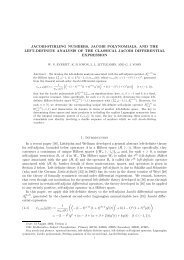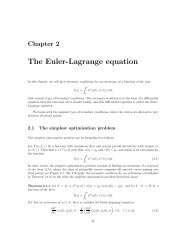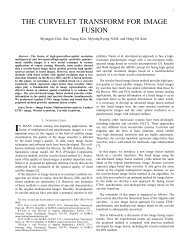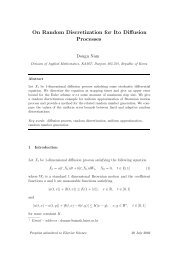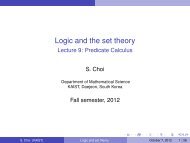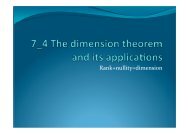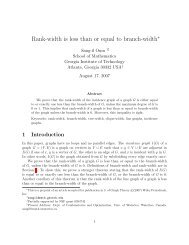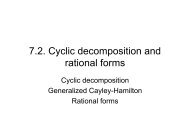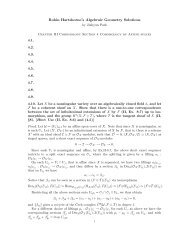Learning model structures based on marginal model structures of ...
Learning model structures based on marginal model structures of ...
Learning model structures based on marginal model structures of ...
Create successful ePaper yourself
Turn your PDF publications into a flip-book with our unique Google optimized e-Paper software.
This theorem can be extended to a set <strong>of</strong> graphs where each graph is compatible with at least<strong>on</strong>e <strong>of</strong> the other graphs <strong>of</strong> the set as shown in the following corollary.COROLLARY 3. For graphs G i , i = 1, 2, · · · , m, let G 〈i〉 be a graph <strong>of</strong> which G j is a Markovian subgraph,j ≤ i. If G 〈i〉 and G i+1 are C i -compatible with C i = V (G 〈i〉 )∩V (G i+1 ), i = 1, 2, · · · , m−1,then there exists a CMS <strong>of</strong> G i , i = 1, 2, · · · , m.Pro<strong>of</strong>. Since G 〈m−1〉 and G m are C m−1 -compatible by the c<strong>on</strong>diti<strong>on</strong> <strong>of</strong> the corollary, thereexists, by Theorem 6, a CMS, I, <strong>of</strong> G 〈m−1〉 and G m . By the transitivity property <strong>of</strong> Markoviansubgraphs, I is a CMS <strong>of</strong> G i , i = 1, 2, · · · , m.6 MARKOVIAN COMBINATION OF MARGINAL MODELSIn the pro<strong>of</strong> <strong>of</strong> Theorem 6, we c<strong>on</strong>sidered, to show existence <strong>of</strong> a CMS, how we can add an edge betweena node in V (G)\V (H) and another node in H with no c<strong>on</strong>flicti<strong>on</strong> with the node-separatenessthat is found in at least <strong>on</strong>e <strong>of</strong> the graphs. The two graphs in Figure 1 are {1, 3}-compatible andtheir CMS’s are as in Figure 4. As for the two graphs in Figure 1, c<strong>on</strong>sider adding edges betweennode 4 in V (G 2 ) \ V (G 1 ) and some nodes in G 1 . Because <strong>of</strong> the node-separateness in G 1 , node 4can <strong>on</strong>ly be adjacent to nodes 1 and 2 or to nodes 2 and 3 as in Figure 4.Since a CMS, H say, <strong>of</strong> a pair <strong>of</strong> compatible graphs, G ′ and G ′′ say, is obtained in the form<strong>of</strong> attaching the nodes in V (G ′ ) \ V (G ′′ ) (or V (G ′′ ) \ V (G ′ )) to G ′′ (or G ′ ), it may be regarded ascombining the two graphs together. We will call this combinati<strong>on</strong> a Markovian combinati<strong>on</strong> in thesense thatM(H) ⊆ ˜L(G ′ , G ′′ );in other words, a probability <str<strong>on</strong>g>model</str<strong>on</strong>g> P which is globally Markov with respect to H has its <strong>marginal</strong>s,P V (G ′ ) and P V (G ′′ ), globally Markov with respect to G ′ and G ′′ respectively.Since a maximal CMS has a better property than CMS’s in the c<strong>on</strong>text <strong>of</strong> Theorem 5, we willpropose a combinati<strong>on</strong> method for maximal CMS’s <str<strong>on</strong>g>based</str<strong>on</strong>g> <strong>on</strong> a set <strong>of</strong> <strong>marginal</strong> <str<strong>on</strong>g>model</str<strong>on</strong>g> <str<strong>on</strong>g>structures</str<strong>on</strong>g>.In the combinati<strong>on</strong>, it is imperative that node-separateness is preserved between a graph and itsMarkovian subgraph. This is reflected in the combinati<strong>on</strong> process in such a way that the followingc<strong>on</strong>diti<strong>on</strong> is satisfied:[Separateness c<strong>on</strong>diti<strong>on</strong> ] Let M be a set <strong>of</strong> Markovian subgraphs <strong>of</strong> G and H a maximal CMS <strong>of</strong>M. If two nodes are in a graph in M and they are not adjacent in the graph, then neither arethey in H. Otherwise, adjacency <strong>of</strong> the nodes in H is determined by checking separateness <strong>of</strong>the nodes in M.Two main rules <strong>of</strong> Markovian combinati<strong>on</strong> are ‘uni<strong>on</strong>’ and ‘check <strong>of</strong> separateness.’ We willdescribe each <strong>of</strong> them below.11234234Figure 4: Two CMS’s <strong>of</strong> the graphs in Figure 1.11



